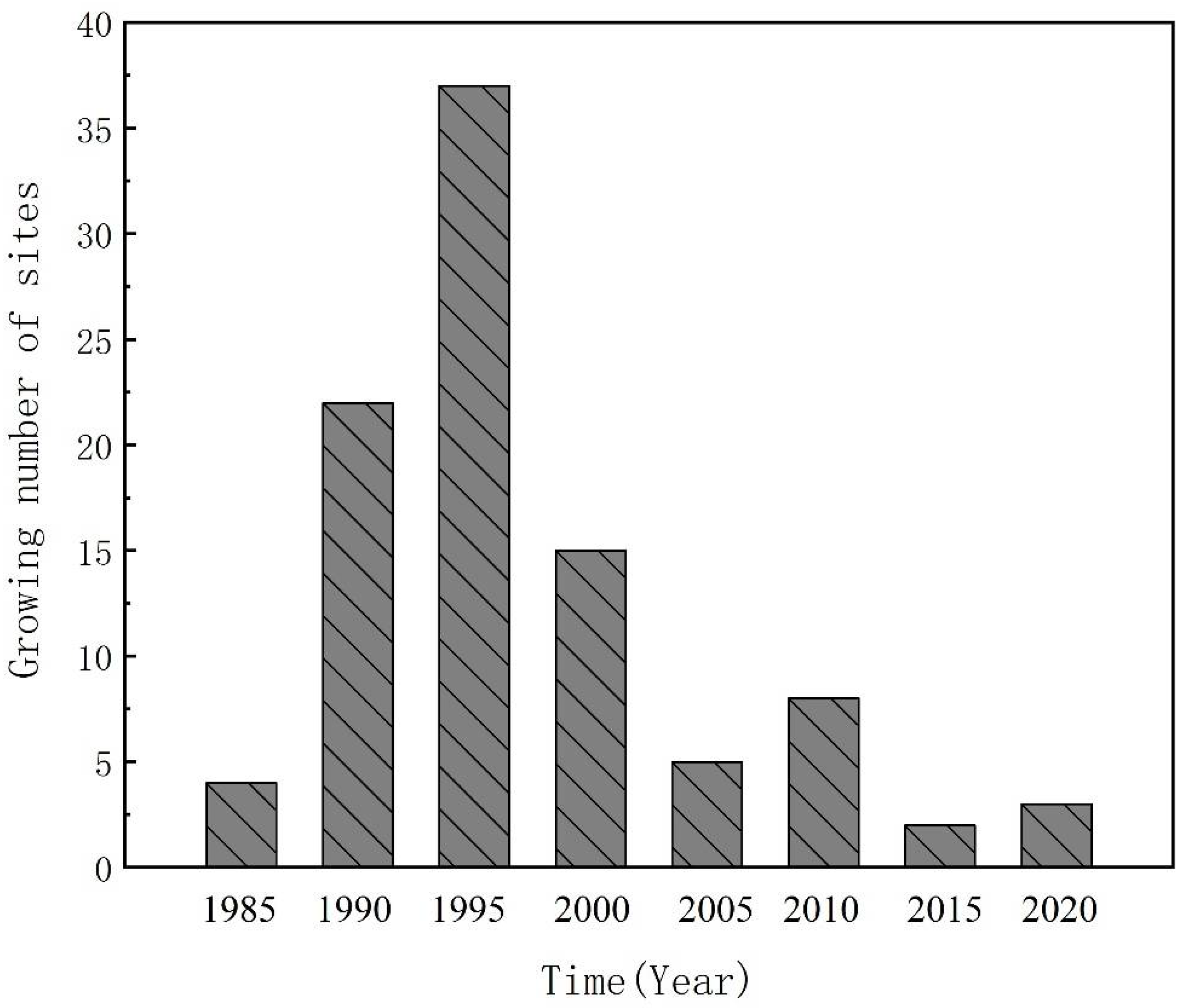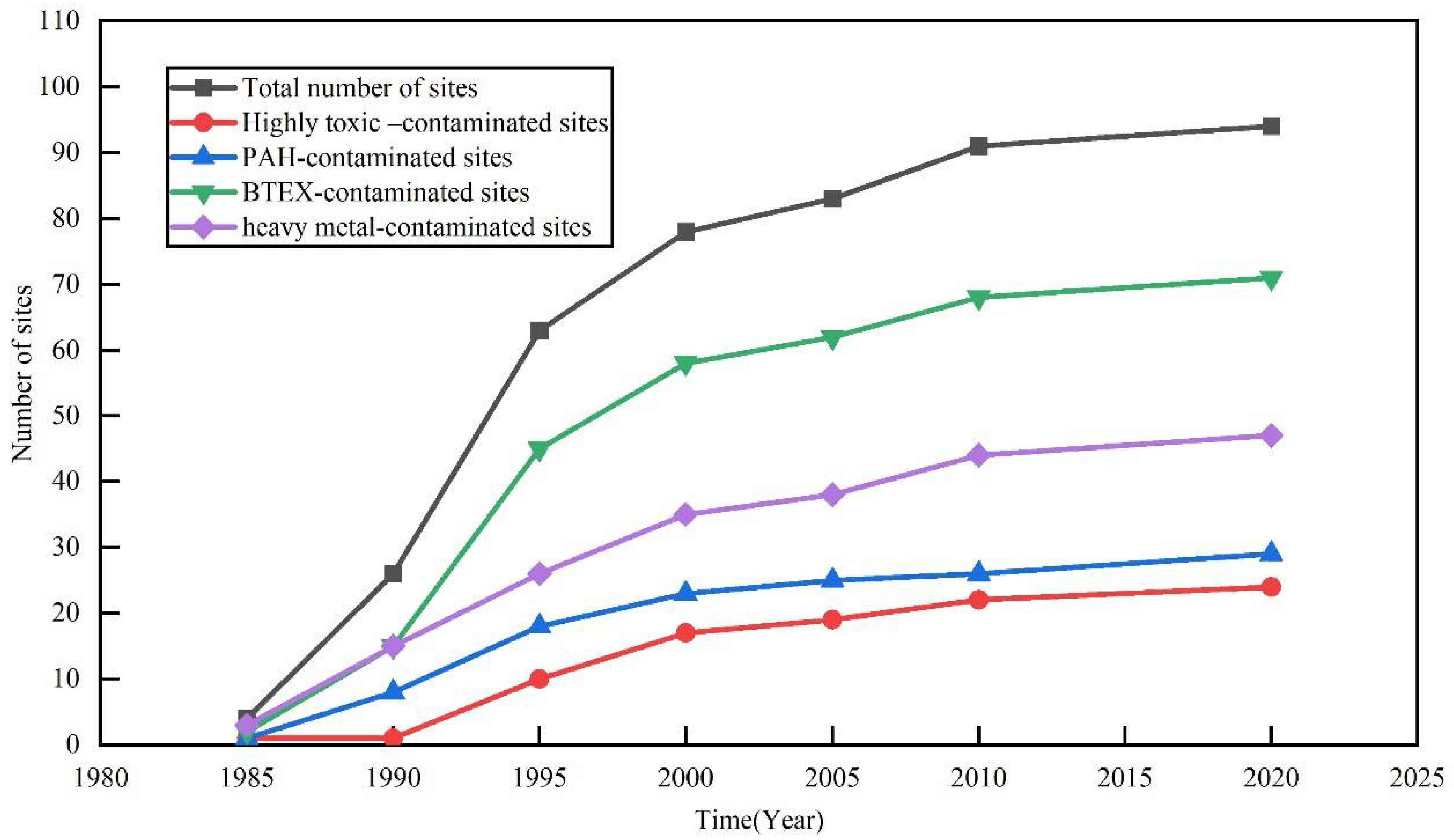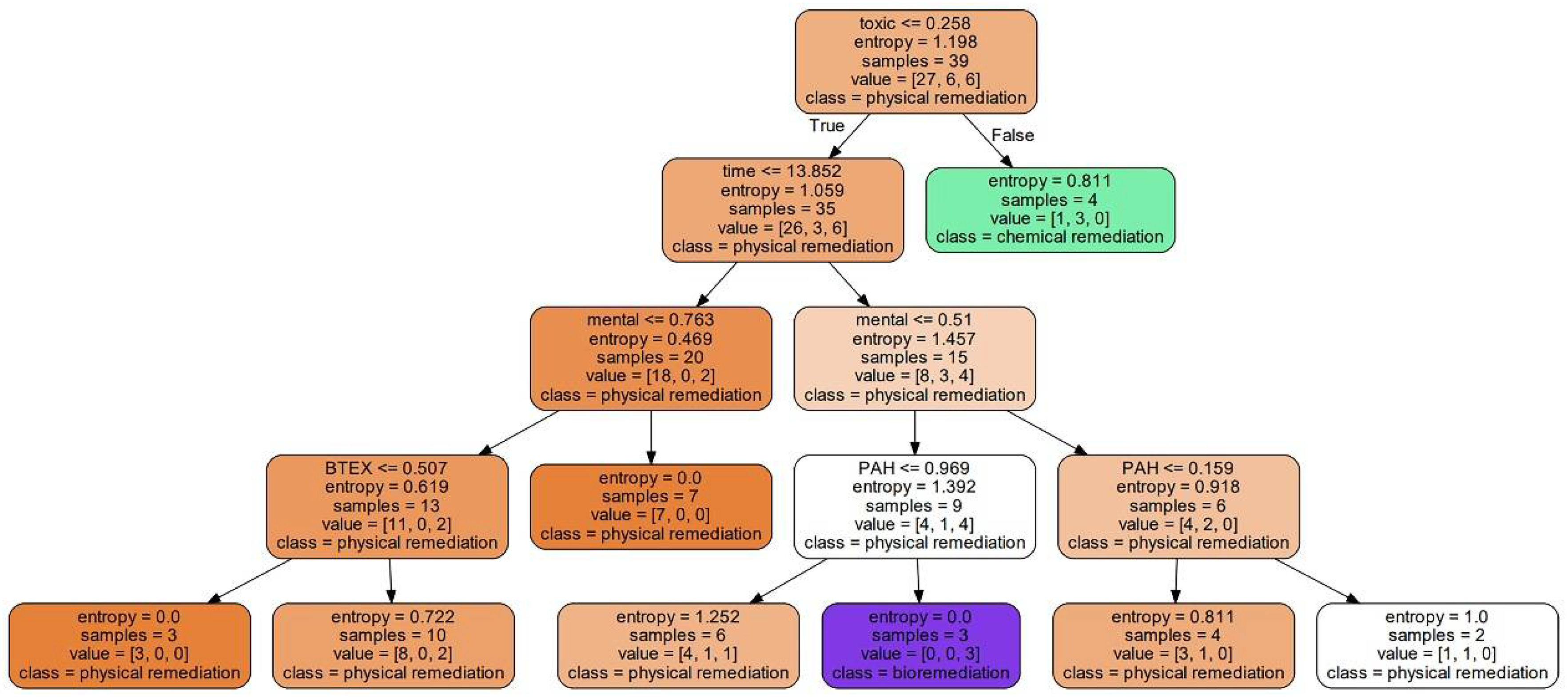Big-Data Analysis and Machine Learning Based on Oil Pollution Remediation Cases from CERCLA Database
Abstract
:1. Introduction
2. Methods
2.1. Data Collection
2.2. Model Selection and Methods
3. Results and Discussion
3.1. Changes in Pollutants and Remediation Methods over Time
3.2. Changes in Pollutants and Remediation Methods in Space
3.3. Exploration of Remediation Methods by Machine Learning
4. Conclusions
- (1)
- Among the three repair methods, physical repair was the most commonly used one, with an application probability stable at over 80% at all time periods. Chemical remediation techniques were rarely used before 1990, and the frequency of chemical remediation techniques selected for most periods after 1990 reached more than 50%. The frequency of selecting bioremediation technology was the smallest, less than 50% at all times. However, the proportion of bioremediation applications has risen in general.
- (2)
- California and Texas are the major oil-producing states in the U.S. The proportion of sites containing metal pollution was about 50% in these two states. BTEX was more common in both states, and its occurrence probability in Texas and California was about 75%. There were more sites containing highly toxic substances in California than in Texas, reaching more than 25%. On the other hand, there were more sites containing PAHs in Texas than in California, reaching more than 40%.
- (3)
- Of the seven characteristic variables selected for this paper, considering California alone, the presence or absence of highly toxic substances has the greatest influence on the choice of remediation method, and the weight is 0.274, while in Texas the feature with the highest weight is heavy metal content, which has a weight of 0.318. The combined model of these two states showed that the presence or absence of BTEX substances and the geographical location of the site largely influenced the choice of remediation method, and the weights reached 0.301 and 0.288, respectively.
Author Contributions
Funding
Institutional Review Board Statement
Informed Consent Statement
Data Availability Statement
Acknowledgments
Conflicts of Interest
References
- Wiener, J.B. Developments in the Law of Toxic Waste Litigation: Bankruptcy and Insurance Issues. Harvard Law Review 1985, 99, 1458. [Google Scholar]
- Hamilton, J.T.; Viscusi, W.K. How Costly Is “Clean”? An Analysis of the Benefits and Costs of Superfund Site Remediations. J. Policy Anal. Manag. 1999, 18, 2–27. [Google Scholar] [CrossRef]
- Ma, B.Q.; Tang, C.; Wang, X. Thought on the love canal moment and superfund for groundwater prevention and control in China. Groundwater 2021, 43, 18–21+55. [Google Scholar]
- Jasanoff, S. Review: Love Canal revisited:A Hazardous Inquiry: The Rashomon Effect at Love Canal. Issues Sci. Technol. 1998, 14, 15–31. [Google Scholar]
- U.S. Environmental Protection Agency. The Origins of EPA|US Environmental Protection Agency. Available online: www.epa.gov/history/origins-epa (accessed on 15 May 2021).
- Johnston, J.E.; Lim, E.; Roh, H. Impact of upstream oil extraction and environmental public health: A review of the evidence. Sci. Total Environ. 2019, 657, 187–199. [Google Scholar] [CrossRef] [PubMed]
- Jia, X.Y.; O’Connor, D.; Shi, Z.; Hou, D.Y. VIRS based detection in combination with machine learning for mapping soil pollution. Environ. Pollut. 2021, 268, 115845. [Google Scholar] [CrossRef] [PubMed]
- Wu, G.Z.; Kechavarzi, C.; Li, X.G.; Wu, S.M.; Pollard, S.J.T.; Sui, H.; Coulon, F. Machine learning models for predicting PAHs bioavailability in compost amended soils. Chem. Eng. J. 2013, 223, 747–754. [Google Scholar] [CrossRef]
- Bao, H.Y.; Wang, J.F.; Li, J.; Zhang, H.; Wu, F.Y. Effects of corn straw on dissipation of polycyclic aromatic hydrocarbons and potential application of backpropagation artificial neural network to prediction model for PAHs bioremediation. Ecotoxicol. Environ. Saf. 2019, 186, 109745. [Google Scholar] [CrossRef] [PubMed]
- Shadrin, D.; Pukalchik, M.; Kovaleva, E.; Fedorov, M. Artificial intelligence models to predict acute phytotoxicity in petroleum contaminated soils. Ecotoxicol. Environ. Saf. 2020, 194, 1010410. [Google Scholar] [CrossRef] [PubMed]
- Cipullo, S.; Snapir, B.; Prpich, G.; Campo, P.; Coulon, F. Prediction of bioavailability and toxicity of complex chemical mixtures through machine learning models. Chemosphere 2019, 215, 388–395. [Google Scholar] [CrossRef] [PubMed] [Green Version]
- Olawoyin, R. Application of backpropagation artificial neural network prediction model for the PAH bioremediation of polluted soil. Chemosphere 2016, 161, 145–150. [Google Scholar] [CrossRef] [PubMed]
- Amin, J.S.; Kuyakhi, H.R.; Bahadori, A. Prediction of formation of polycyclic aromatic hydrocarbon (PAHs) on sediment of Caspian Sea using artificial neural networks. Pet. Sci. Technol. 2019, 37, 1987–2000. [Google Scholar] [CrossRef]
- Palansooriya, K.N.; Li, J.; Dissanayake, P.D.; Suvarna, M.; Li, L.Y.; Yuan, X.Z.; Sarkar, B.; Tsang, D.C.W.; Rinklebe, J.; Wang, X.N.; et al. Prediction of Soil Heavy Metal Immobilization by Biochar Using Machine Learning. Environ. Sci. Technol. 2022, 56, 4187–4198. [Google Scholar] [CrossRef] [PubMed]
- Lhafra, F.Z.; Abdoun, O. Hybrid Approach to Recommending Adaptive Remediation Activities Based on Assessment Results in an E-learning System Using Machine Learning. In Proceedings of the 3rd International Conference on Advanced Intelligent Systems for Sustainable Development (AI2SD), Tangier, Morocco, 21–26 December 2020; pp. 679–696. [Google Scholar]
- Zhu, X.Z.; Wang, X.N.; Ok, Y.S. The application of machine learning methods for prediction of metal sorption onto biochars. J. Hazard. Mater. 2019, 378, 120727. [Google Scholar] [CrossRef] [PubMed]
- Kaplan, G.; Aydinli, H.O.; Pietrelli, A.; Mieyeville, F.; Ferrara, V. Oil-Contaminated Soil Modeling and Remediation Monitoring in Arid Areas Using Remote Sensing. Remote Sens. 2022, 14, 2500. [Google Scholar] [CrossRef]






| Total Number of Sites | Highly Toxic–Contaminated Site | Highly Toxic–Contaminated Site/Total Number of Sites | PAH-Contaminated Sites | PAH-Contaminated Sites/Total Number of Sites | BTEX-Contaminated Sites | BTEX-Contaminated Sites/Total Number of Sites | Heavy Metal-Contaminated Sites | Heavy Metal-Contaminated Sites/Total Number of Sites |
|---|---|---|---|---|---|---|---|---|
| 4 | 1 | 25.0% | 1 | 25.0% | 2 | 50.0% | 3 | 75.0% |
| 26 | 1 | 3.8% | 8 | 30.7% | 15 | 57.7% | 15 | 57.7% |
| 63 | 10 | 15.8% | 18 | 28.6% | 45 | 71.4% | 26 | 41.3% |
| 78 | 17 | 21.9% | 23 | 29.5% | 58 | 74.3% | 35 | 44.9% |
| 83 | 19 | 22.9% | 25 | 30.1% | 62 | 74.7% | 38 | 45.8% |
| 91 | 22 | 24.2% | 26 | 28.5% | 68 | 74.7% | 44 | 48.3% |
| 94 | 24 | 25.5% | 29 | 30.9% | 71 | 75.5% | 47 | 50.0% |
| Pollutant Category | Number of Sites in California with Such Pollution | Percentage of Sites in California with Such Pollutants | Number of Sites in Texas with Such Pollution | Percentage of Sites in Texas with Such Pollutants | Number of Sites in Alaska with Such Pollution | Percentage of Sites in Alaska with Such Pollutants | Number of Sites in Oklahoma with Such Pollution | Percentage of Sites in Oklahoma with Such Pollutants |
|---|---|---|---|---|---|---|---|---|
| BTEX | 71 | 75.5% | 37 | 74.0% | 5 | 71.4% | 8 | 53.3% |
| PAHs | 29 | 30.9% | 20 | 40.0% | 3 | 42.9% | 5 | 33.3% |
| Highly Toxic | 24 | 25.5% | 7 | 14.0% | 4 | 57.1% | 2 | 13.3% |
| Heavy Metal | 47 | 50.0% | 28 | 56.0% | 5 | 71.4% | 12 | 80.0% |
| Features | Weight |
|---|---|
| Time | 0.248 |
| Space | 0.000 |
| BTEX | 0.035 |
| PAHs | 0.225 |
| Heavy Metal | 0.218 |
| Highly Toxic | 0.274 |
| Organic pollutants | 0.000 |
| Features | Weight |
|---|---|
| Time | 0.179 |
| Space | 0.000 |
| BTEX | 0.000 |
| PAHs | 0.214 |
| Heavy Metal | 0.318 |
| Highly Toxic | 0.000 |
| Organic pollutants | 0.288 |
| Features | Weight |
|---|---|
| Time | 0.147 |
| Space | 0.288 |
| BTEX | 0.301 |
| PAHs | 0.124 |
| Heavy Metal | 0.088 |
| Highly Toxic | 0.083 |
| Organic pollutants | 0.145 |
Publisher’s Note: MDPI stays neutral with regard to jurisdictional claims in published maps and institutional affiliations. |
© 2022 by the authors. Licensee MDPI, Basel, Switzerland. This article is an open access article distributed under the terms and conditions of the Creative Commons Attribution (CC BY) license (https://creativecommons.org/licenses/by/4.0/).
Share and Cite
Li, H.; Zhou, Z.; Long, T.; Wei, Y.; Xu, J.; Liu, S.; Wang, X. Big-Data Analysis and Machine Learning Based on Oil Pollution Remediation Cases from CERCLA Database. Energies 2022, 15, 5698. https://doi.org/10.3390/en15155698
Li H, Zhou Z, Long T, Wei Y, Xu J, Liu S, Wang X. Big-Data Analysis and Machine Learning Based on Oil Pollution Remediation Cases from CERCLA Database. Energies. 2022; 15(15):5698. https://doi.org/10.3390/en15155698
Chicago/Turabian StyleLi, Hangyu, Ze Zhou, Tao Long, Yao Wei, Jianchun Xu, Shuyang Liu, and Xiaopu Wang. 2022. "Big-Data Analysis and Machine Learning Based on Oil Pollution Remediation Cases from CERCLA Database" Energies 15, no. 15: 5698. https://doi.org/10.3390/en15155698
APA StyleLi, H., Zhou, Z., Long, T., Wei, Y., Xu, J., Liu, S., & Wang, X. (2022). Big-Data Analysis and Machine Learning Based on Oil Pollution Remediation Cases from CERCLA Database. Energies, 15(15), 5698. https://doi.org/10.3390/en15155698









